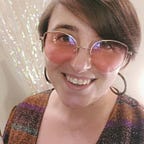An Ode to Sci-fi, Horror, and Sci-fi Horror
I watched the movie Alien when I was about twelve years old during a sleepover. My friend and I slept in the living room with an electric lantern on the coffee table between us. The pitch-black was thick and nearly tangible around us. Of course, I had to get up for a glass of water. I still vividly remember staring down the long path into the kitchen wondering if the drooling, snarling, towering xenomorph lurked somewhere in the dark.
Horror has always held an innate appeal to me. Even as a young kid, I was obsessed with the Goosebumps books, but the one that ended up being my favorite wasn’t one I expected. It was called How I Learned to Fly. The front cover was a POV illustration of someone looking down at a pair of legs in jeans and a set of red Converse sneakers as he floated above the suburban green. It wasn’t scary, but it stuck with me — I think maybe because it was so sad. (Spoilers incoming.)
The protagonist is gifted with the ability to fly. It’s amazing at first, but soon everyone treats him like a circus performer or a lab rat, and his life is changed forever. He ends up hiding his gift just so he can go back to a life of anonymity. I remember feeling that it was a surprisingly poignant story for a kid’s book. Not sure why it continues to follow me decades later.
One of my favorite shows, believe it or not, was Beyond Belief: Fact or Fiction hosted by Jonathan Frakes. I recreated it with a VHS camcorder, handwritten title cards, and a couple of dedicated friends. We acted out urban legends and paranormal shenanigans, including a full-on, agonizingly long recreation of The Blair Witch Project in the forest around my neighborhood. All those tapes are among the most treasured artifacts of my childhood.
At seventeen years old, I witnessed death. Watching the process of dying, the human transition from life into death, was too big, too existential, too real for my sheltered, teenage soul. I had a major depressive breakdown, and it was in the throes of this darkness that I read House of Leaves.
This work is hardly even worthy of the label “book” because it’s so experimental, and yet it skates by with the classification by technicality: it is a story told through words on paper. (I find it amusing that the author added “A Novel” on the front cover in small print. It feels almost like a sly little joke.)
A troubled man named Johnny Truant discovers the unfinished manuscript of his deceased upstairs neighbor. The manuscript is an academic analysis of a collection of videos called The Navidson Tapes. The tapes are records made by a group of documentary filmmakers as they investigate a house that’s inexplicably larger on the inside––and continues to grow.
At first, a door appears. The door leads down a five-and-a-half-minute hallway into pure darkness. A spiral staircase appears and descends into depths that are even darker still. What’s worse, animalistic noises echo in the shadows. They are not alone in the ever-growing, ever-changing labyrinth.
Weaving the story through three different perspectives (the tape transcripts, the deceased neighbor’s detailed analysis of the transcripts, and Johnny Truant’s disturbing, autobiographical footnotes) creates a dizzying depiction of multiple minds unraveling at the same time. Reading this while my own mind strayed into a dark, labyrinthine unreality made it even more frightening.
And yet, I found comfort in the madness. It remains one of my favorite books of all time, and I can scarcely think of anything else that has excited and inspired me as much as House of Leaves continues to.
As far as science-fiction is concerned, my joys are many. Star Wars. Star Trek. Firefly. Cowboy Bebop. Arrival. Annihilation. Interstellar. Invasion of the Bodysnatchers. Blade Runner. Stargate. The Matrix. The X-Files.
What I love about science fiction is how it provides an inspiring, fascinating backdrop of scientific imagination to tell deeply human stories that connect across time and space. We can look forward into the future to communicate what’s happening in the present, and that’s unbelievably cool. We can explore the bounds of imaginative fiction to express truth.
Horror and science fiction are natural complements because we all have deep fears about what we don’t understand or don’t know. We’re all anxious about the future to varying degrees. Will technology surpass us? Will outsiders destroy us? Will we destroy ourselves?
Science fiction and horror give us the stage and cast to bear witness to our own evolution — the dreams we hope for and the nightmares we dread. Life is a never-ending state of transition, and sci-fi horror shows us the fear, ingenuity, and triumph woven through this weird human experience.
